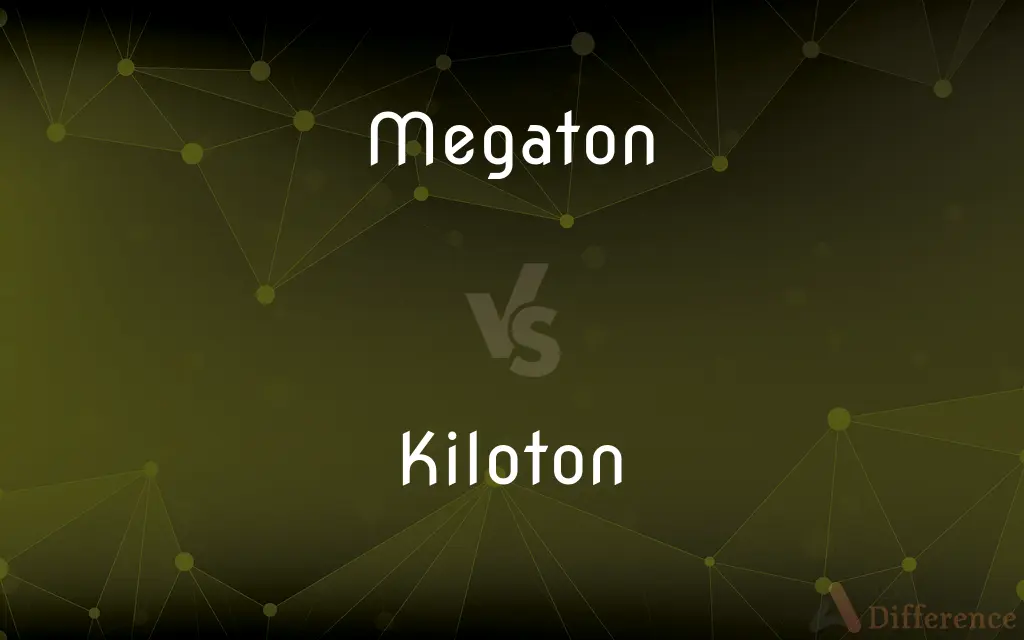Megaton vs. Kiloton — What's the Difference?
By Fiza Rafique & Urooj Arif — Updated on March 10, 2024
Megaton and kiloton are units of explosive energy, with a megaton being equivalent to 1,000 kilotons.

Difference Between Megaton and Kiloton
Table of Contents
ADVERTISEMENT
Key Differences
A megaton is a unit of energy commonly used to describe the explosive power of nuclear weapons, equivalent to one million tons of TNT. A kiloton, on the other hand, is smaller, representing the energy equivalent to one thousand tons of TNT. Both units measure the vast energy released in explosions, but megatons indicate significantly larger magnitudes.
The term "megaton" is often used in discussions about large-scale nuclear weapons and major asteroid impacts, highlighting events with catastrophic energy releases. Kilotons are used for smaller nuclear devices and conventional explosives, applicable in scenarios from military ordnance to asteroid impact assessments.
One key difference lies in their application: megaton-range weapons or events are capable of causing widespread devastation over large areas, possibly affecting global climates and environments. Kiloton-range explosions, while still incredibly powerful, tend to have more localized effects, often associated with tactical nuclear weapons or large conventional bombs.
In historical context, nuclear tests and bombings are usually quantified in kilotons or megatons. For example, the atomic bombs dropped on Hiroshima and Nagasaki during World War II were in the kiloton range, whereas later Cold War-era nuclear tests often reached into the megaton range.
Understanding the distinction between megaton and kiloton is crucial in the fields of nuclear physics, military strategy, and disaster preparedness, as it helps in assessing the potential impact and scale of explosive events.
ADVERTISEMENT
Comparison Chart
Definition
Equivalent to one million tons of TNT explosive energy.
Equivalent to one thousand tons of TNT explosive energy.
Scale
Used for describing larger explosive events, like major nuclear weapons or significant asteroid impacts.
Applied to smaller nuclear devices, large conventional explosives, and smaller asteroid impacts.
Application
Indicates catastrophic events with widespread devastation.
Associated with tactical weapons and localized effects.
Historical Context
Associated with large-scale nuclear tests and theoretical asteroid impacts.
Linked to smaller nuclear weapons and conventional military ordnance.
Importance
Essential in discussions about strategic nuclear capabilities and global disaster scenarios.
Important for tactical military planning and emergency preparedness for smaller-scale events.
Compare with Definitions
Megaton
Indicates extremely high energy levels, suitable for describing large-scale nuclear events.
Asteroid impacts with yields in the megaton range could have global environmental consequences.
Kiloton
A unit of energy equivalent to one thousand tons of TNT.
The atomic bomb dropped on Hiroshima had an explosive yield of approximately 15 kilotons.
Megaton
Relevant in strategic military contexts and global disaster impact assessments.
A megaton-class nuclear weapon could obliterate an entire city and significantly affect the surrounding region.
Kiloton
Used to describe smaller nuclear explosions and large conventional bombs.
Modern tactical nuclear weapons often have yields in the kiloton range.
Megaton
A unit measuring the explosive power equivalent to one million tons of TNT.
The largest nuclear test ever conducted had a yield of over 50 megatons.
Kiloton
Kiloton measurements are critical for assessing the impact of smaller-scale nuclear events and emergency response planning.
Emergency services use kiloton estimates to prepare for and mitigate the effects of potential nuclear incidents.
Megaton
Linked to discussions about the most powerful nuclear weapons developed during the Cold War.
The Tsar Bomba, detonated by the Soviet Union, had a yield of around 50 megatons, making it the most powerful nuclear device ever tested.
Kiloton
Associated with the atomic bombings of World War II and smaller nuclear tests.
The Trinity Test, the first nuclear weapon detonation, yielded about 20 kilotons of TNT.
Megaton
Understanding megaton-scale events is crucial for global security and disaster preparedness planning.
Scientists study megaton-level asteroid impacts to assess potential threats to Earth and devise mitigation strategies.
Kiloton
Applies to a wide range of military and scientific contexts, including tactical nuclear strategies and controlled demolitions.
Kiloton-level explosives are used in scenarios where precision and minimization of collateral damage are key.
Megaton
A unit of explosive power chiefly used for nuclear weapons, equivalent to one million tons of TNT
H-bombs of fifteen megatons each
Kiloton
A unit of weight or capacity equal to 1,000 metric tons.
Megaton
A unit of explosive energy equal to that of one million metric tons of TNT.
Kiloton
An explosive energy equivalent to that of 1,000 metric tons of TNT.
Megaton
A measure of the strength of an explosion or a bomb based on how many million tons of TNT would be needed to produce the same energy.
Kiloton
A measure of the strength of an explosion or a bomb based on how many thousand tons of TNT would be needed to produce the same energy.
That's a 300-kiloton nuclear warhead.
Megaton
One million tons.
Kiloton
One thousand tons.
Megaton
A measure of explosive power (of an atomic weapon) equal to that of one million tons of TNT
Kiloton
One thousand tons
Megaton
One million tons
Kiloton
A measure of explosive power (of an atomic weapon) equal to that of 1000 tons of TNT
Common Curiosities
Have megaton-range weapons been used in conflict?
While megaton-range weapons have been tested, no megaton-range nuclear weapon has been used in armed conflict; the largest yields used in war were in the kiloton range.
Can conventional explosives reach kiloton or megaton levels?
Conventional explosives can reach kiloton levels, especially with large bombs, but reaching megaton levels is generally beyond the scope of non-nuclear explosives.
How is the yield of a nuclear explosion measured?
The yield is typically estimated based on observations of the explosion's effects, such as blast damage, seismic data, and the size of the fireball, and then compared to the known yields of previous explosions.
Are there environmental impacts from kiloton and megaton explosions?
Yes, both can have significant environmental impacts, but megaton explosions can cause global climate effects, such as "nuclear winter" scenarios.
How do megaton and kiloton yields affect blast radius?
The larger the yield, the greater the blast radius. A megaton explosion affects a much wider area than a kiloton explosion, with exponentially more devastating effects.
How do scientists and military planners use kiloton and megaton measurements?
They use these measurements to estimate the potential damage from explosions, plan for defense and emergency response, and understand the capabilities of nuclear arsenals.
How does the altitude of a nuclear detonation affect its impact?
The altitude at which a nuclear weapon is detonated can significantly influence the extent of the blast damage, thermal radiation, and subsequent fallout, with different altitudes optimized for different types of effects.
What role does simulation play in understanding kiloton and megaton impacts?
Due to the limited testing of nuclear weapons in modern times, simulations play a crucial role in understanding the potential impacts of kiloton and megaton explosions, including blast effects, thermal radiation, and fallout dispersion.
What is the significance of kiloton and megaton measurements in disarmament discussions?
These measurements are crucial in arms control and disarmament negotiations, helping to quantify and limit the destructive potential of nuclear arsenals.
Can an explosion be less than a kiloton?
Yes, many explosions, including smaller nuclear tests and conventional explosives, are measured in tons of TNT or even smaller units, indicating yields below one kiloton.
Share Your Discovery

Previous Comparison
Defy vs. Resist
Next Comparison
Common vs. UncommonAuthor Spotlight
Written by
Fiza RafiqueFiza Rafique is a skilled content writer at AskDifference.com, where she meticulously refines and enhances written pieces. Drawing from her vast editorial expertise, Fiza ensures clarity, accuracy, and precision in every article. Passionate about language, she continually seeks to elevate the quality of content for readers worldwide.
Co-written by
Urooj ArifUrooj is a skilled content writer at Ask Difference, known for her exceptional ability to simplify complex topics into engaging and informative content. With a passion for research and a flair for clear, concise writing, she consistently delivers articles that resonate with our diverse audience.














































